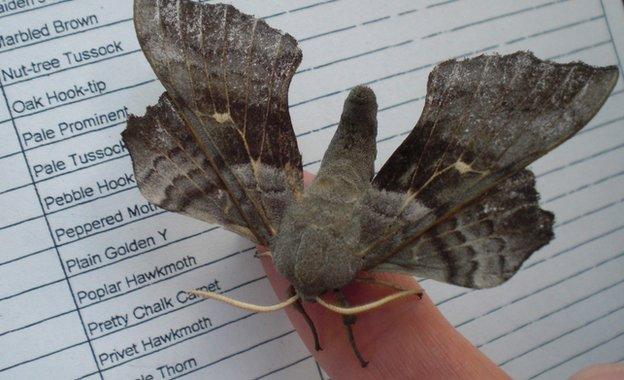Citizen scientists get to grips with moth survey
- Published

During a month long survey, 87 moth species, including the impressive poplar hawk moth, were recorded
About 13,000 moths have been captured and recorded by citizen scientists in southern England in a project described as the largest of its kind.
Researchers hope the data will help them understand how species will migrate in response to climate change.
During the month-long survey, 87 different species were recorded.
The survey is one of the <link> <caption>Earthwatch</caption> <url href="http://www.earthwatch.org/" platform="highweb"/> </link> projects being highlighted at the organisation's annual lecture on Thursday evening in central London.

The project has helped researchers to find which species are able to disperse into new habitats
One of the speakers, Dan Bebber - Earthwatch's head of climate change research - will use his presentation to deliver some of the main findings from the survey.
During the course of a month in the summer of 2009, volunteers from the charity helped a team of researchers from the University of Oxford mark the wings of more than 13,000 moths.
The survey, known as a mark-release-recapture (MRR) experiment, was co-ordinated by Dr Eleanor Slade in conjuction with the university's Wildlife Conservation Research Unit (WildCRU), in a well-researched woodland habitat in Wytham Woods, Oxfordshire.
More than 650 moths, from 41 species, were recaptured.
Dr Bebber said: "A small percentage of those marked moths were recaptured again, but from the number we did recapture we were able to determine what factors affect the ability of moths to disperse."
The largest recorded distance travelled by a one moth - a broad-bordered yellow underwing - was 13.7km.
Dr Bebber said the survey seemed to suggest that woodland species were the most effective when it came to dispersing.
"Relatively large species with pointed wings that preferred woodland landscapes dispersed further than other species," he told BBC News.
However, he added that even these species did require wooded corridors, such as hedgerows, to disperse and were not found on maiden trees - single trees found in fields.
"The habitats within the UK had been fragmented for a long time," Dr Bebber explained.
"It is probably the ones that can move relatively long distances that are still found in the UK.
"Those species that were not able to disperse so well have probably disappeared over millennia."
Dr Bebber will present his findings at the Earthwatch Institute's annual lecture, Climate Change and Forests, which is being chaired by TV presenter Kate Humble.
- Published6 January 2012
- Published7 November 2011
- Published18 February 2011